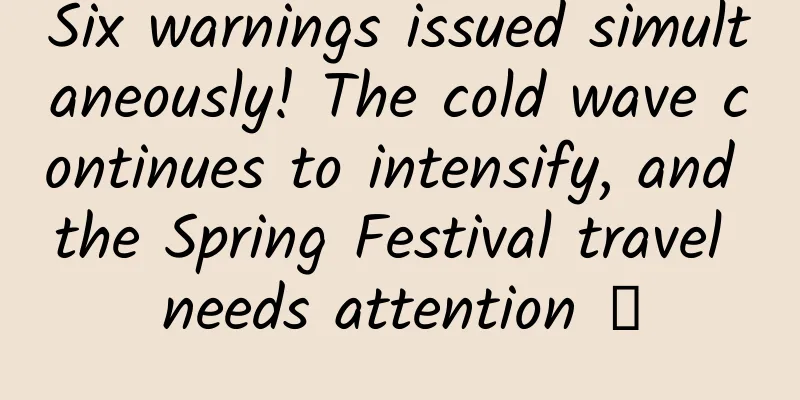Six warnings issued simultaneously! The cold wave continues to intensify, and the Spring Festival travel needs attention →

|
The Central Meteorological Observatory continued to issue 6 warnings at 6:00 on the 20th: Orange cold wave warning Yellow warning for freezing Yellow fog warning Blizzard Blue Warning Blue warning for high winds Blue warning for severe convective weather From February 20 to 22, the cold wave will continue to affect central and eastern my country, with some areas facing medium to high risks of heavy snow, low temperature, rain, snow and freezing disasters. Please pay attention to safety during your Spring Festival travel return↓↓↓ Orange cold wave warning Affected by the cold wave, it is expected that from February 20 to February 23, most of central and eastern my country will experience a drop in temperature from north to south, with the daily average or minimum temperature generally dropping by 8 to 12°C. The temperature in southern North China, western Huanghuai, Jianghuai, Jianghan, Jiangnan, central and northern South China, and Guizhou will drop by 12 to 18°C. Among them, the cumulative temperature drop in parts of southern Hunan, eastern Guizhou, and northern Guangxi may reach more than 20°C. Around February 23, the minimum temperature line of 0°C will be pushed south to the southern part of Jiangsu and Anhui, southern Hunan, and southern Guizhou. It is expected that from 8:00 on February 20 to 8:00 on February 22, parts of southern North China, western Huanghuai, western Jianghuai, Jianghan, central and northern Jiangnan, eastern Guizhou, and northern Guangxi will successively cool down by 8 to 10°C. Among them, Jianghan, central and western Jiangnan, and eastern Guizhou will cool down by 12 to 14°C, and parts of southern Hunan, southern Jiangxi, eastern Guizhou, and northern Guangxi will cool down by more than 16°C. Yellow warning for freezing It is predicted that from 8:00 on February 20 to 8:00 on February 21, there will be freezing rain or ice pellets in parts of central and southern Henan, southern Shandong, northern Anhui, northern and western Hubei, etc., with the amount of freezing rain being 1 to 5 mm, and more than 7 mm in some local areas. Yellow fog warning It is expected that from day to night on the 20th, there will be heavy fog in the western waters of the East China Sea, the coastal waters of Zhejiang and Fujian, the Taiwan Strait, the coastal waters of Guangdong, and the coastal waters of Guangxi, with visibility less than 1 km. In addition, from the morning to the morning of the 20th, there will be heavy fog in southeastern Zhejiang and southeastern Guangdong, with visibility less than 500 meters in some areas. Blizzard Blue Warning It is expected that from 8:00 on February 20 to 8:00 on February 21, parts of northern Shaanxi, central and southern Shanxi, central and southern Hebei, central and eastern Shandong and northern Shandong, northern and southwestern Henan, northwestern Hubei, western and southeastern Tibet will have heavy snow. Among them, parts of southeastern Shanxi, southern Hebei, northwestern and eastern Shandong, southwestern Henan, and northwestern Hubei will have heavy snow (10 to 19 mm). The new snow depth in some of the above-mentioned areas is 3 to 7 cm, and locally it may reach more than 10 cm. Blue warning for high winds It is expected that from 8:00 on February 20 to 8:00 on February 21, parts of central and western Tibet, central and southern Qinghai, central and western Inner Mongolia, southern Liaoning, southeastern North China, western and eastern Huanghuai, western and northern Jianghuai will have winds of 5 to 7, with gusts of 8 to 9. Bohai Sea, Bohai Strait, and most areas of the Yellow Sea will have strong winds of 7 to 8, with gusts of 9 to 10. From 8:00 on February 21 to 8:00 on February 22, parts of central and western Tibet, central and southern Qinghai, eastern North China, western and eastern Huanghuai, and western Jianghuai will have winds of 5 to 6, with gusts of 7 to 8. Bohai Sea, Bohai Strait, and most areas of the Yellow Sea will have strong winds of 7 to 8, with gusts of 9 to 10. Blue warning for severe convective weather It is expected that from 8:00 on February 20 to 8:00 on February 21, there will be thunderstorm gale or hail weather of 8 to 10 degrees in parts of southwestern Anhui, eastern and southern Hubei, central and northern and southwestern Hunan, central and northern Jiangxi, southeastern Guizhou, northeastern Guangxi, etc.; parts of central and southern Anhui, southwestern Jiangsu, eastern Hubei, southern and western Hunan, northern Jiangxi, northeastern Guangxi, etc. will have short-term heavy rainfall, with the maximum hourly rainfall of 20 to 30 mm, and even more than 35 mm in some local areas. It is expected that the main impact period of severe convection will be from this afternoon to tonight. We are currently in the peak period of the Spring Festival travel rush. Rain, snow and freezing weather have a great impact on traffic. Please keep an eye on the weather forecast and adjust your itinerary in time. The central and eastern regions will remain cold for a while after the temperature drops. Please remember to add clothes to keep warm. The following are travel safety tips and warmth-keeping guidelines. 【Travel safety tips】 1. How to drive more safely on icy and snowy roads? In cold, rainy and snowy weather, people who need to drive should remember to "reduce speed, control distance, and turn on tail lights", drive carefully and travel safely. When encountering traffic control, you must obey the instructions of the on-duty traffic police and queue up in turn. 1. Slow-moving vehicles Reduce your speed and drive at a constant speed as indicated by the traffic department, which is generally 20-30 km/h. The vehicle speed should be stable while driving, and sudden acceleration should be avoided. When accelerating or decelerating, the accelerator should be pressed or released slowly to prevent the drive wheels from slipping due to sudden acceleration or deceleration. 2. Keep safe distance between vehicles Increase the distance between vehicles, which should be 2 to 3 times the normal distance, to leave enough space for longer braking distance. Drive along the track of the vehicle in front, generally do not overtake, keep the engine speed even, and do not accelerate, decelerate or brake suddenly. 3. Slow down first, then turn When driving on a curve or slope, you should lightly press the brake to slow down in advance. When you need to turn, slow down first, increase the turning radius appropriately and steer gently to avoid skidding due to sudden increase in front wheel resistance caused by turning too hard. When braking, brake lightly, and then increase the braking force after the speed gradually decreases. At the same time, use the braking force of the engine to brake. Do not brake suddenly or hard to avoid the vehicle skidding. 4. Emergency response methods for emergencies When you encounter skidding or drifting caused by over-braking or accelerating too quickly, you should immediately release the brake pedal and use continuous braking instead of turning the steering wheel suddenly. Turning the steering wheel to change the skidding state will not correct the situation and may even backfire. When entering a curve too fast and the vehicle starts to skid, first release the accelerator pedal, then slightly correct the direction, and keep adjusting between steering and correcting, but not too much, and do not exceed the normal driving position of the wheels. If necessary, lightly brake to slow down and correct the direction. When you encounter an over-steer situation that causes the rear end of the car to swing forward and tend to turn around, you should also release the accelerator first, and gently but quickly reverse the steering wheel. You must return to the center line and use the brakes to reduce speed if necessary. 2. Make these preparations before driving on the road When driving in cold, rainy or snowy weather, you need to make adequate preparations before hitting the road. 1. Check the vehicle condition before departure Low temperatures can easily cause vehicle failures. Before departure, you should carefully check the vehicle's power system, braking system, lighting system and tire conditions to avoid vehicle breakdowns on the highway and rear-end collisions. During the peak travel period of the Spring Festival, gas stations and charging piles in highway service areas are all in saturated operation. Traveling vehicles should be fully refueled and fully charged in advance to avoid breakdowns due to insufficient battery life. Once a traffic accident or vehicle failure occurs and the vehicle cannot move, the people on the vehicle must evacuate to the outside of the highway guardrail in a timely manner and call the police for help in a timely manner. When driving in heavy snow, you should clear the snow off the car body and windows and try to maintain a good driving vision. When driving in bad weather, you should turn on the low beam headlights, clearance lights, and front and rear position lights. When visibility is less than 100 meters, you should also turn on the hazard warning flashers. The lights not only illuminate the way home, but also make you more conspicuous. 2. Prepare the necessary items When driving in cold, rainy, or snowy weather, you can carry anti-skid chains, hardwood blocks, waste cardboard boxes, and other items with you in case of emergency situations such as tire slippage on icy and snowy roads. Before departure, you should replace snow tires or install anti-skid chains in advance. Before departure, check whether there is a triangular warning sign on the car and whether the warning sign is intact. In addition, in order to cope with bad weather at night and in rain and snow, you need to always have flashlights and reflective vests in your car. Classification and usage scenarios of anti-skid chains At present, the mainstream anti-skid chains on the market are divided into the following 4 types: Iron anti-skid chains: mainly used on large vehicles, they are noisy, difficult to install and remove, and cause serious wear on tires; Tendon anti-skid chain: The anti-skid effect is average and not durable, suitable for short-term use on ordinary ice and snow roads; Rubber anti-skid chain: It has the advantages of low temperature resistance, wear resistance, good elasticity, strong friction and good tensile resistance, and is suitable for long-term use in family cars; Wire rope anti-skid chain: The structure is relatively simple, easy to install, and has a long service life. The disadvantage is that it causes greater wear on the tire and is relatively expensive. 【Guide to keeping warm】 The elderly, pregnant women, infants and young children, patients with chronic diseases such as cardiovascular and cerebrovascular diseases, respiratory diseases, and people who work or engage in activities outdoors for a long time are easily affected by cold weather and need to pay special attention to health risks. Among them, elderly patients with chronic diseases have reduced metabolic function and relatively less heat production, and their body temperature regulation system has difficulty adapting to changes in external temperature; being in a cold environment for a long time can cause frostbite, which can easily have adverse effects on pregnant women and fetuses. The "Keep Warm and Prevent Cold" health tips issued by the National Health Commission clearly state that sensitive groups should focus on the following points: add cotton-padded clothes and trousers to keep warm, and pay special attention to keeping the head, chest, neck and limbs warm; try to reduce going out, and take warming measures when you must go out; pay attention to rest and avoid excessive fatigue; increase physical exercise moderately to enhance resistance; families using coal stoves for heating should beware of gas poisoning; pay attention to weather forecasts and cold wave news so that necessary protective measures can be taken in time. If the human body is exposed to cold for a long time and shows signs such as chills, collapse, memory loss, and drowsiness, this may be "hypothermia". Experts from the Environmental Institute of the Chinese Center for Disease Control and Prevention said that when encountering these signs, the body temperature should be measured in time, and if the body temperature is below 35 degrees Celsius, medical treatment should be sought immediately. When medical treatment cannot be obtained immediately, the person with hypothermia should be taken to a warm room or residence as soon as possible; wet clothes should be taken off in time; hot drinks should be taken, and relevant measures should be taken to warm the core area of the body. After the situation is relieved, medical treatment should be sought as soon as possible. Comprehensive sources: Central Meteorological Bureau, CCTV News, Xinhuanet, etc. |
<<: The Dirtiest Thing on Eggs: You Might Be Eating Them! (Not What You Think)
Recommend
Magical contrast: Why can some people not open bottle caps but split watermelons with their bare hands?
In the eyes of many people, the strength of girls...
When will the cherry blossoms bloom in 2022? When is the best time to view cherry blossoms in Wuhan?
Cherry blossoms are bright and colorful with lush...
After studying dozens of popular apps, I will tell you how to design a good "Like" function
It is no exaggeration to say that "like"...
3 methodologies for selling goods through live streaming!
Nowadays, the so-called sales promotion is actual...
General Bradley's 2021 Trading Strategy Lecture
General Bradley's 2021 Trading Strategy Lectur...
2 long product guide pictures completed in 3 days. Why are people so keen on guides?
I graduated from university with a major in e-com...
700 paying users and 1,000 UGC operation cases in 3 months, how did they do it?
I have seen many products that were poorly made. ...
Analysts say the iPod product line will be replaced by the iWatch
Although Apple has not yet made it clear whether ...
When you are confused about operations, you can use it to find a breakthrough!
A friend who does e-commerce asked on WeChat: &qu...
Infiniti partially recalls more than 200 QX60 hybrid vehicles
Recently, Nissan (China) Investment Co., Ltd. fil...
Several reasons why Alibaba’s operations are so strong!
% ignore_pre_1 % When we say Alibaba’s operations ...
Early spring is as hot as early summer? Be careful! All-around cold front is coming!
According to the latest meteorological data analy...
Changba Chen Hua: How I increased the number of Changba users to 260 million!
I am a serial entrepreneur . My first project was...
Mobei Class SEO Course 9th VIP Course 10th Optimization SEO Course 2020 Synchronous 10th
The 9th session of SEO training has started, and ...
Short video APP product analysis report!
The structural framework of this article is shown...









![Xiaoke's film and television commentary transfer course quickly teaches you film and television commentary [video course] Baidu cloud download](/upload/images/67cc214663ba4.webp)